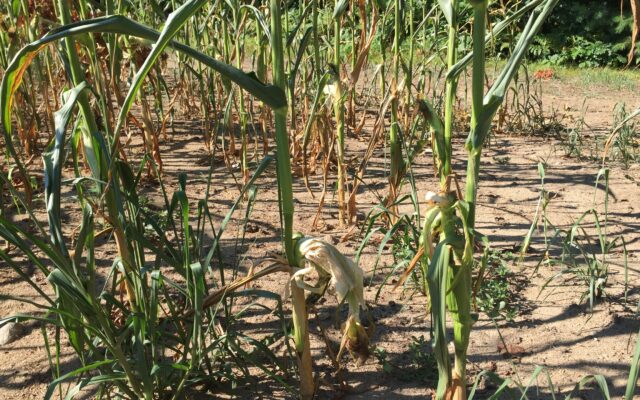
Drought conditions fry Maine gardens
By Elizabeth Walztoni, Bangor Daily News Staff
For the second time in several years, Bobbi Jo Chambers is hauling water from the river.
Chambers, from the Aroostook County town of Island Falls, has been gardening for four decades and typically uses rainwater, which was relatively abundant earlier in the growing season but has since dried up.
She’s growing tomatoes to can and a variety of pepper plants, but has let some other plants die and will have to wait for a fall planting to get harvests from others because of recent heat and dryness.
After a mostly cool and wet spring, dry conditions statewide have recently ramped up into a drought and increased fire risk. They’re also threatening crops, leading growers like Chambers to worry about their water supplies while choosing which crops to water and which to let die.
The entire Maine coast is in a moderate drought as of Aug. 15, according to the National Weather Service, with much of the state “abnormally dry” farther north. Conditions are likely to get worse in the next few weeks, without any signs of significant rain ahead, the weather service warned late.
The National Drought Mitigation Center maintains a map where growers can submit dry condition reports. Aroostook County reports note potato growers are irrigating “nonstop” during the critical period when the tubers grow in size, and farms without irrigation are seeing plants wilt. Another reported their pond had dropped a foot and a half in less than three weeks.
Down East, blueberries shriveled, tree leaves wilted and grass died, reports said; in greater Bangor, plants wilted, some crops died and fruit appeared dry in what some observers said were the driest conditions they have seen.
Moderate drought conditions lead to lower yields for hay and grain growers, stress trees and hinder honey production, according to the U.S. Drought Monitor. The next level of drought would hurt specialty crops, dry up irrigation ponds, raise hay prices, make trees vulnerable to insect damage and lead wildlife to look to farms for food.
Things aren’t that dire yet for Anne Cauble, a Harpswell vegetable gardener who said that she isn’t seeing full-blown drought conditions. But she has gotten strategic with her watering and let some crops die off for fear of her well running dry.
Cauble didn’t have to water at all for the first half of the growing season, she said; it was almost a shock to need to start. The wet start to summer means her plants have plenty of foliage, but fruit has been slower to ripen than normal.
She turns the hose on low and moves it around the garden in five-minute intervals between other garden chores, placing it at the base of plants to minimize evaporation.
Cauble is also letting some things go by earlier than usual, such as her green beans and annual flowers. Planters that she covered with a layer of mulch earlier in the season seem to be retaining moisture for longer.
Layers of mulch are one recommended way to deal with drought in a garden, as they can keep soil cooler and wetter while suppressing weeds, according to the North Carolina State University Cooperative Extension. Common choices are wood chips for perennials or trees and grass clippings or straw for garden plants.
The extension also recommends avoiding fertilizing, pruning or otherwise encouraging new plant growth.
Watering garden plants more heavily but less often should encourage them to develop deeper roots and weather drought conditions better, according to the extension. Drip irrigation, which puts a controlled amount of water right at the roots, is considered the most efficient on a limited water supply.
Different crops most need water at different times, according to the University of Pennsylvania; for example, fruit trees need water from the time they flower until they produce fruit, while it’s only critical for corn plants when ears are developing.